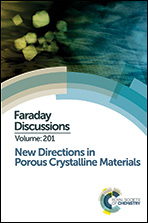Study of the scale-up, formulation, ageing and ammonia adsorption capacity of MIL-100(Fe), Cu-BTC and CPO-27(Ni) for use in respiratory protection filters†
Abstract
The metal–organic frameworks (MOFs) MIL-100(Fe), Cu-BTC and CPO-27(Ni) were synthesised in 1 kg batches. The materials were then formed in two different industrially relevant ways. Firstly, dry granulation was used to produce pellets which were sieved to give material with a 300–1000 μm size, and the fines were subsequently recycled to mimic a large scale industrial process. Secondly, wet granulation with a polymer was used to produce granules which were again sieved to 300–1000 μm. XRD data shows that the structures of MIL-100(Fe) and CPO-27(Ni) remain intact during both forming processes, whilst Cu-BTC is shown to degrade during processing. This is in line with the ammonia adsorption data obtained for the formed materials which evaluated the ammonia adsorption capacity of the materials using breakthrough measurements. MIL-100(Fe) and CPO-27(Ni) are shown to have capacities of 47 mg g−1 and 62 mg g−1 respectively whilst Cu-BTC has a decreased capacity of 37 mg g−1 from 97 mg g−1 upon forming. The formed materials were also aged at 25 °C and 80% humidity for a week and the ammonia adsorption capacity re-evaluated. As expected, Cu-BTC decomposed under these conditions, whilst MIL-100(Fe) and CPO-27(Ni) show slightly decreased ammonia adsorption capacities of 36 mg g−1 and 60 mg g−1 respectively.
- This article is part of the themed collection: New directions in porous crystalline materials


 Please wait while we load your content...
Please wait while we load your content...